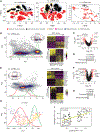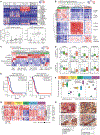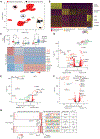The Phenotypes of Proliferating Glioblastoma Cells Reside on a Single Axis of Variation
- PMID: 31554641
- PMCID: PMC7161589
- DOI: 10.1158/2159-8290.CD-19-0329
The Phenotypes of Proliferating Glioblastoma Cells Reside on a Single Axis of Variation
Abstract
Although tumor-propagating cells can be derived from glioblastomas (GBM) of the proneural and mesenchymal subtypes, a glioma stem-like cell (GSC) of the classic subtype has not been identified. It is unclear whether mesenchymal GSCs (mGSC) and/or proneural GSCs (pGSC) alone are sufficient to generate the heterogeneity observed in GBM. We performed single-cell/single-nucleus RNA sequencing of 28 gliomas, and single-cell ATAC sequencing for 8 cases. We found that GBM GSCs reside on a single axis of variation, ranging from proneural to mesenchymal. In silico lineage tracing using both transcriptomics and genetics supports mGSCs as the progenitors of pGSCs. Dual inhibition of pGSC-enriched and mGSC-enriched growth and survival pathways provides a more complete treatment than combinations targeting one GSC phenotype alone. This study sheds light on a long-standing debate regarding lineage relationships among GSCs and presents a paradigm by which personalized combination therapies can be derived from single-cell RNA signatures, to overcome intratumor heterogeneity. SIGNIFICANCE: Tumor-propagating cells can be derived from mesenchymal and proneural glioblastomas. However, a stem cell of the classic subtype has yet to be demonstrated. We show that classic-subtype gliomas are comprised of proneural and mesenchymal cells. This study sheds light on a long-standing debate regarding lineage relationships between glioma cell types.See related commentary by Fine, p. 1650.This article is highlighted in the In This Issue feature, p. 1631.
©2019 American Association for Cancer Research.
Conflict of interest statement
Disclosure of Potential Conflicts of Interest
S. Muller is a scientist at and has ownership interest (including patents) in Genentech. No potential conflicts of interest were disclosed by the other authors.
Figures





Comment in
-
Malignant Gliomas: Simplifying the Complexity.Cancer Discov. 2019 Dec;9(12):1650-1652. doi: 10.1158/2159-8290.CD-19-1081. Cancer Discov. 2019. PMID: 31792122
References
MeSH terms
Grants and funding
LinkOut - more resources
Full Text Sources
Other Literature Sources
Medical
Molecular Biology Databases
Research Materials

